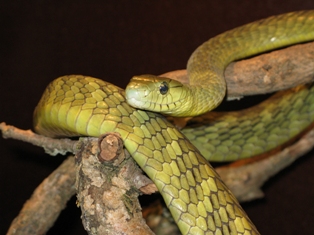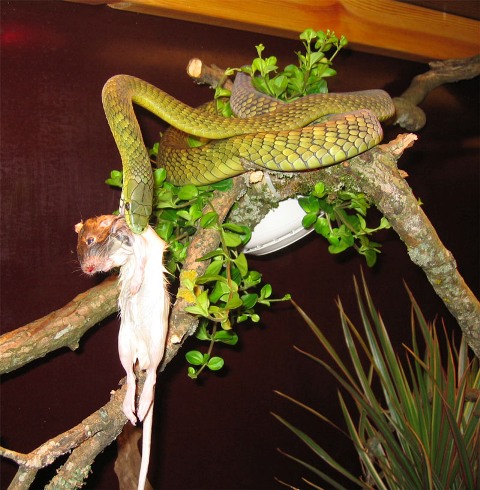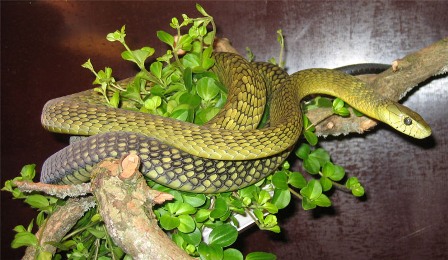Jameson's Mamba Captive Care
from
Miro Voutilainen
on
January 14, 2011
View comments about this article!
The Jameson's Mamba
Dendroaspis
jamesoni kaimosae
by Miro Voutilainen, Sweden
Family: Elapidae
Genus: Dendroaspis
Species: jamesoni
Subspecies: kaimosae
Common name(s): Traill's Green Mamba, East
African Jameson's Mamba, Jameson's blacktail mamba.
Local names: Omeja, Moubamba, Inyenzi, Bukizi,
Obiya, Nduna.

Geographical distribution and habitat selection:
Jameson's mamba (Dendroaspis jamesoni) is distributed
from the western coast to the central parts of equatorial
Africa. The subspecies kaimosae inhabits the eastern parts
of the range. The species occur in Angola, Burundi,
Cameroon, Cabinda, Central African Republic, Democratic
Republic of Congo, Equatorial Guinea, Gabon, Ghana,
Kenya, Nigeria, Rwanda, Sudan, Togo and Uganda.
Jameson's mambas are usually found from sea level to
altitudes of 2200 metres above the sea. Jameson's
mambas inhabits rainforests, woodlands and thickets.
According to local people these mambas are quite often
found near towns, within city parks and farms.
General shape: The Jameson's mamba is a large
species and adults reach a total length of 180 to 250 cm.
The tail makes up approximately 25% of the total lengh.
These snakes have relatively long and narrow heads. The
eyes are medium sized with a round pupil. Dorsal scales
are narrow, smooth and oblique.

Habits: Jameson's mambas are extremely fast
and agile arboreal snakes. These snakes spend most of
their time in trees but they may descend to the ground to
bask or in pursuit of prey. Jameson's mambas mainly feed
on rodents and birds, but they are also known to take
lizards and eggs. These snakes have good eyesight and
use it to actively pursue their prey. The prey is killed by
repeated strikes until it succumbs from the neurotoxic venom. When
provoked mambas usually try to escape. If not allowed to
flee, the snake may flatten the neck and hiss loudly to
make an intimidating threat. If the warning signs are
ignored Jameson's mamba may deliver several bites in
succession.
Reproduction: Jameson's mambas are oviparous
and the clutch consists of 6-17 eggs. Males are known to
combat, pressing each other onto the ground. Combats
may last for several hours. The actual mating takes place
in trees with both male and female tails hanging down.
Enclosure: I recommend that Jameson's mambas
are kept in large spacious enclosures which have been
equipped with branches and live plants. A few
hidingplaces, such as trap boxes are required. I keep my
pair in an enclosure 240cm wide, 120cm high and 80cm
deep. I use two trap boxes, one in each side of the
enclosure (cold and warm). I've never seen my mambas
drink from the water bowl I keep on the floor in the
terrarium. Instead they drink water that has collected in
their coils after they have been sprayed.The temperature
during the day is 32°C on the warm side and 26° C on the
cold side and at night around 24°C. I keep the relative
humidity at 75-85%.
Captivity Behavior and Handling: Jameson's
mambas are supposed to be quite nervous in captivity but
the pair I have are relatively docile. However, they are very
alert and will follow every movement. My mambas are
active during they day and I often find them moving about
in the branches. At night they hide in the trap boxes or
plants. Due to their agility and speed mambas can be a
handful to handle. I use trap boxes when I need to move
my individuals. If necessary I use tongs and/or hooks to
maneuver them. Captive breeding seems to be very rare.
As far as I know only a few successful breedings have
been recorded in Europe.
Symptoms of envenomation: Jameson's mamba
venom is dangerous and potentially lethal. The venom is
principally neurotoxic because of the action of
Dendrotoxins and Fasciculins. Local effects include
swelling and severe pain. Possible systemic effects are
headache, vomiting, abdominal pain, diarrhea, nausea,
collapse or convulsions. Neurotoxic paralysis is common.

Treatment: Mamba bites can cause severe, even
lethal systemic (paralytic) effects. They require urgent
assessment & treatment. Admit at least overnight. Instant
antivenin therapy is the most important treatment.
I wrote this article 2007 when I kept my adult pair of Dendroaspis jamesoni
kaimosae. If you find anything that is indistinct or wrong, please let me
know.
|
Jameson's Mamba Captive Care
|
Reply
|
|
by heythem500 on August 28, 2013
|
Mail this to a friend!
|
|
Oh my God!Snake eat a mouse ^ _ ^ always renewed information about the life of snakes will only be found here
|
| |
|
Jameson's Mamba Captive Care
|
Reply
|
|
by samim on September 1, 2016
|
Mail this to a friend!
|
To see the venomous snakes of the world..........
plz seee the video on youtube..
link
https://www.youtube.com/watch?v=x-I0dfQd3s4
|
| |
|
Email Subscription
You are not subscribed to discussions on this article.
Subscribe!
My Subscriptions
Subscriptions Help
Other Captive Care Articles
 Captive Care and Breeding of the Monocle
Captive Care and Breeding of the Monocle
 Keeping Kraits
Keeping Kraits
 The Black Mamba
The Black Mamba
 Captive Care of the Russell's Viper
Captive Care of the Russell's Viper
 Captive care notes for D. angusticeps
Captive care notes for D. angusticeps
|

